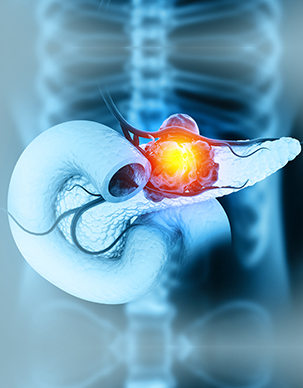Hepatobiliary and Pancreatic Cancers

Liver cancer occurs when abnormal cells in the liver grow uncontrollably.
- Hepatocellular carcinoma (HCC) is the most common type of liver cancer, making up nearly all liver cancer cases.
Other types of liver cancer include:
- Intrahepatic Cholangiocarcinoma (IHC): Cancer in the liver's bile ducts.
- Angiosarcoma: A rare cancer affecting blood vessels in the liver.
Bile duct cancer (cholangiocarcinoma): Cancer in bile ducts connecting the liver to the small intestine. The types of include:
- Intrahepatic Cholangiocarcinoma: Inside liver bile ducts.
- Perihilar Cholangiocarcinoma (Klatskin tumor): Where smaller bile ducts merge.
- Distal Cholangiocarcinoma: Cancer in the ducts closer to the small intestine.
Pancreatic cancer develops when cells in the pancreas mutate. It is mostly exocrine tumors like adenocarcinoma, but neuroendocrine tumors (NETs), also known as islet cell carcinoma, account for less than 10% of cases.
About 1.7% of people will develop pancreatic cancer 5 , and 1.1% will develop liver or bile duct cancer in their lifetime.
Symptoms
- HCC & IHC: Lump or pain under the right rib cage/near shoulder, jaundice, weight loss, nausea, fatigue, dark urine, loss of appetite.
- Bile Duct Cancer: Symptoms appear late due to bile duct blockage: abdominal pain, fever, itchy skin, jaundice, dark urine, light stools, weight loss, and vomiting.
- Pancreatic Cancer: Jaundice, dark urine, light stools, abdominal/back pain, fatigue, itchy skin, nausea, bloating, appetite loss, weight loss, blood clots, new-onset diabetes.
Risk Factors
- Liver Cancer: Chronic HBV/HCV, cirrhosis, hemochromatosis, Wilson's disease, diabetes, nonalcoholic fatty liver disease, aflatoxin exposure, heavy alcohol use.
- Bile Duct Cancer: Bile duct abnormalities, stones, Clonorchis infection, colitis, cirrhosis, HBV/HCV, HIV, IBD, alcohol, diabetes, obesity, smoking, toxins.
- Pancreatic Cancer: Smoking, obesity, Type 2 diabetes, chemical exposure, chronic/hereditary pancreatitis, BRCA mutations.
Diagnosis and Test:
- blood tests, including liver function tests and AFP (α-fetoprotein) levels
- Imaging tests such as ultrasound, CT (computed tomography) scan, and MRI (magnetic resonance imaging) help identify liver tumors.
- An angiogram checks blood vessels in the liver, while a biopsy confirms cancer.
If liver cancer is suspected, doctors may order

For intrahepatic cholangiocarcinoma (IHC), tests like ERCP (endoscopic retrograde cholangiopancreatography) and PTC (percutaneous transhepatic cholangiography) are used to examine bile ducts.
Bile duct cancer may require liver function tests, tumor marker tests (CA 19-9, CEA), imaging (ultrasound, CT, MRI), and endoscopic tests (endoscopic ultrasound, ERCP).
Imaging tests (CT, MRI, PET) and blood tests for tumor markers (CA 19-9) are used for pancreatic cancer. Staging laparoscopy helps determine if cancer can be removed. Genetic testing for BRCA1/BRCA2 mutations may help guide treatment, especially for those with a family history.
Treatment
HCC and IHC:
For bile duct cancer, treatment may involve surgery, liver transplant (for early-stage perihilar cholangiocarcinoma), radiation therapy, chemotherapy (systemic, transarterial chemoembolization), targeted therapy, and immunotherapy.
Pancreatic cancer treatment includes surgery (Whipple procedure, distal pancreatectomy, total pancreatectomy), chemotherapy, radiation therapy (often combined with chemotherapy), and targeted therapy to target specific proteins.
Preventive Measures
To reduce liver cancer risk, avoid cirrhosis-causing behaviors, maintain a healthy weight, get the hepatitis B vaccine, and avoid hepatitis C. 2 For bile duct cancer, protect your liver and bile ducts by preventing hepatitis B, C, HIV, excessive alcohol, and smoking, while maintaining a healthy weight.
For pancreatic cancer, it is advisable to avoid smoking, limit alcohol, eat plenty of fruits, vegetables, and whole grains, reduce red meat and processed foods, avoid harmful chemicals, and maintain a healthy weight. If at risk (liver disease, diabetes, obesity, or heavy drinking) consult your doctor about screenings.
Frequently Asked Questions
What is physiotherapy?
Bring to the table win-win survival strategies to ensure proactive domination. At the end of the day, going forward, a new normal that has evolved from generation X is on the
When might I need physiotherapy?
Bring to the table win-win survival strategies to ensure proactive domination. At the end of the day, going forward, a new normal that has evolved from generation X is on the
How does a physiotherapist assess my condition?
Bring to the table win-win survival strategies to ensure proactive domination. At the end of the day, going forward, a new normal that has evolved from generation X is on the

